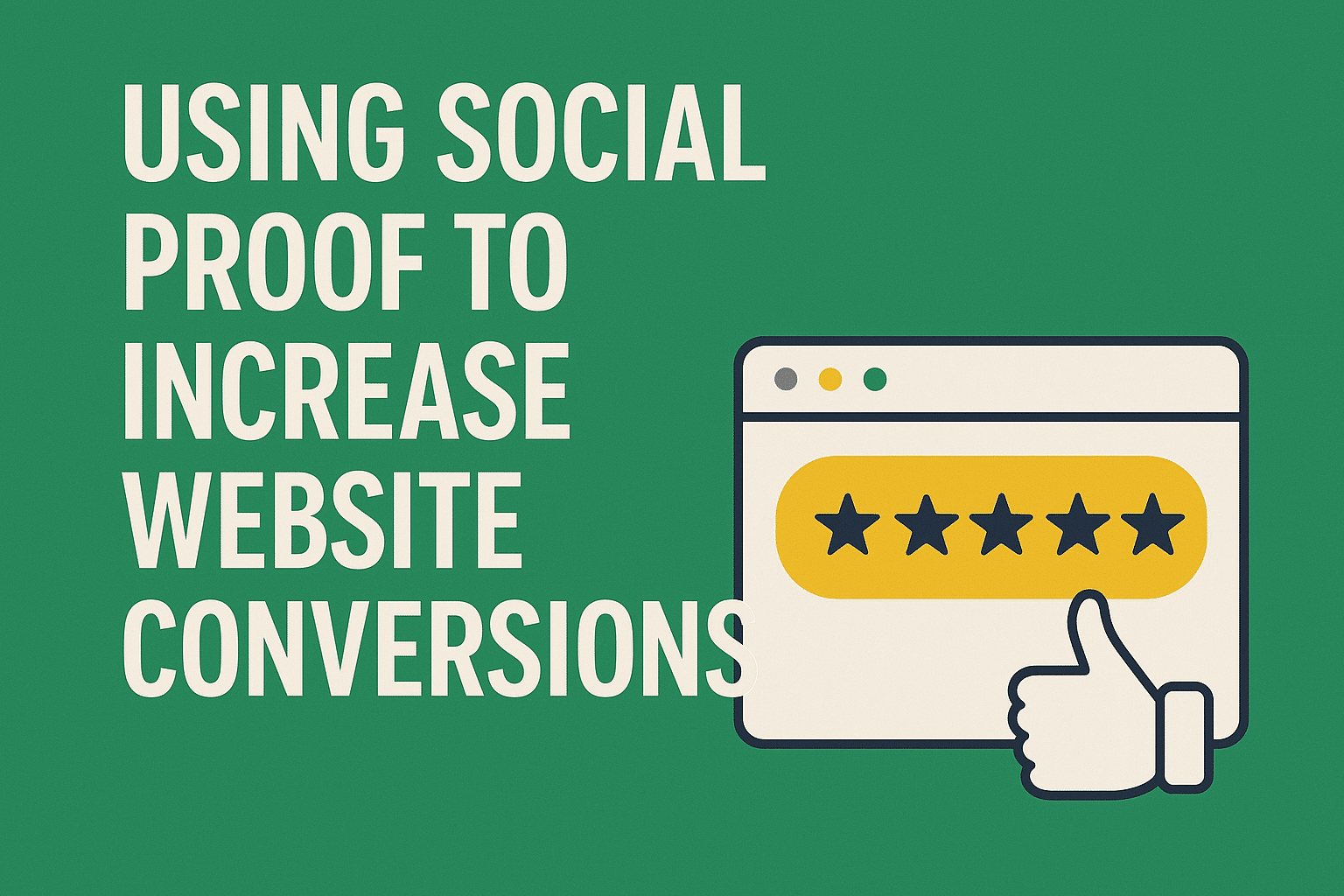Your brand should sound and look like you - no matter where it shows up…

Using Social Proof to Increase Website Conversions
Many website owners underestimate the power of social proof in persuading potential customers. By leveraging testimonials, user reviews, and social media engagement, you can significantly boost your website conversions. People tend to trust the opinions of others, especially when considering a purchase. Incorporating these elements into your site builds trust and credibility, leading to higher sales and customer satisfaction. In this post, you’ll discover practical strategies to implement social proof effectively and watch your conversion rates soar.
Table of Contents
Key Takeaways:
- Leveraging testimonials and reviews can significantly enhance credibility and trust among potential customers, prompting them to complete purchases.
- Displaying user-generated content, such as photos and videos featuring customers using your products, can create a sense of community and belonging.
- Highlighting popular products or best-sellers on your website can tap into the ‘herd mentality,’ encouraging visitors to follow what others are buying.
- Incorporating social media engagement metrics, like follower count or shares, can demonstrate brand popularity and influence buying decisions.
- Utilizing scarcity and urgency tactics, like limited-time offers or low stock notifications, can motivate quicker decision-making among visitors.
The Psychological Mechanics of Social Proof
Understanding the psychological mechanics behind social proof reveals its profound impact on customer behavior. When individuals encounter uncertainty, they often look to others for guidance, leading to a herd mentality. This instinctual behavior can be leveraged to influence decisions on your website, as customers subconsciously seek validation through the actions and opinions of their peers. Highlighting the number of users, positive reviews, or testimonials can instill confidence and encourage potential buyers to follow suit.
The Influence of Peer Behavior on Decision-Making
Peer behavior serves as a powerful motivator in your customers’ decision-making processes. Studies show that people are more likely to purchase a product if they see that others have done so, often referred to as the “bandwagon effect.” By displaying popular items or customer numbers at points of purchase, you’re tapping into this psychological trigger, making potential buyers more likely to commit.
Social Comparison Theory and Consumer Trust
Social Comparison Theory explains how individuals evaluate their own opinions and abilities through comparisons with others. In a commercial context, when consumers observe positive feedback or high engagement from peers, they are more inclined to trust your brand. This phenomenon is particularly effective with user-generated content, which enhances your brand credibility and fosters a community that prospective customers want to be a part of.
Exploring Social Comparison Theory Further
| Key Element | Details |
|---|---|
| Peer Endorsements | Seeing peers actively endorse a product can significantly impact the purchasing decisions of new visitors. |
| Enhanced Trust | Incorporating social proof such as testimonials and user reviews helps build trust by showcasing real experiences. |
| Community Engagement | Engaging with customers through social media and encouraging sharing of their experiences can amplify your brand’s perceived value. |
| Scarcity and Popularity | Indicating limited stock or showcasing best-sellers can create a sense of urgency, driving quicker purchasing decisions. |
Utilizing social comparison mechanisms in your marketing strategy can significantly enhance consumer trust. When potential buyers see that others are satisfied and engaged with your offerings, it not only validates their intentions but also creates a sense of belonging. Much like flocking behavior in nature, consumers feel reassured in their decisions when they observe their peers positively interacting with your brand. By fostering an environment where social proof shines, you cultivate trust that can lead to increased conversions and loyalty. Highlighting user experiences through reviews and testimonials positions your brand as a go-to choice in the market.
Different Forms of Social Proof to Leverage
You have various forms of social proof at your disposal to enhance your website’s credibility and conversions. Integrating testimonials, user reviews, social media mentions, and success stories can significantly influence potential customers. By showcasing authentic experiences and endorsements, you can build trust and assure visitors that your offerings are in high demand. Each form plays a distinct role in appealing to your audience’s psychology and can create a compelling case for choosing your product or service.
Testimonials and User Reviews that Resonate
Including testimonials and user reviews on your website is an effective way to leverage social proof. Satisfied customers sharing their positive experiences not only enhance your credibility but also create an emotional connection with potential buyers. Authentic voices resonate well, so prioritize real feedback that highlights specific features or benefits of your product.
Social Media Mentions and Influencer Endorsements
Your brand can gain substantial credibility through social media mentions and influencer endorsements. When popular figures in your niche speak positively about your product, it reinforces your brand’s reputation and attracts followers who trust their opinions. These endorsements can help you reach wider audiences and stimulate sales through their extensive networks.
Utilizing platforms like Instagram, Twitter, or TikTok to showcase social media mentions allows real-world interactions to foster trust. Videos or posts shared by influencers highlighting your product create a sense of familiarity and authenticity. They act as endorsements that can sway potential customers who might otherwise hesitate to make a purchase. Moreover, tagging your product in these mentions provides direct links, prompting immediate action from their followers.
Success Stories and Case Studies that Convert
Success stories and case studies serve as compelling proof of your product’s efficacy. They not only showcase real-world results but also help potential clients envision their success through your offering. By presenting relatable scenarios, you can instill confidence in your prospects, guiding them toward a decision to convert.
- Case Study 1: XYZ Corp saw a 30% increase in sales within three months of implementing Product A.
- Case Study 2: ABC Ltd. reduced customer support queries by 50% after using your software solution.
- Case Study 3: DEF Inc. improved user engagement by 70% following your consulting services.
- Case Study 4: GHI Solutions generated an extra $200,000 in revenue through targeted marketing strategies you provided.
Your prospects benefit greatly from success stories and case studies. By offering quantifiable results and detailed insights into how your product has positively impacted others, you create a narrative potential customers can relate to. These pieces of content not only enhance the perceived value of your offer but also motivate prospective clients to take action, knowing they’re following a proven path to success.
Crafting Compelling Social Proof Strategies
The effectiveness of social proof lies in its strategic application. You can explore 25 Ways You Can Use Social Proof on Your eCommerce … to tailor approaches that fit your brand’s voice and audience, increasing conversions at every touchpoint. Employ a mix of testimonials, case studies, and user-generated content to create a compelling narrative that resonates with potential customers, making them feel more secure in their purchasing decisions.
Integrating User-Generated Content into Your Website
User-generated content (UGC) serves as authentic endorsements from real customers. Incorporate UGC by displaying customer photos, reviews, and social media posts about your product prominently on your site. You engage potential buyers with genuine experiences that echo their desires and concerns, improving the likelihood of conversion.
Designing Trust Badges and Certifications Effectively
Trust badges and certifications act as visual cues that assure visitors of your website’s legitimacy and security. Place recognizable certification logos near checkout buttons to foster confidence. Data shows that 40% of web users are more likely to make a purchase if they see trust badges, so align these with your target audience’s expectations.
Use badges that your audience respects and finds relevant. For instance, including security certificates like SSL or recognition from industry-specific awards can enhance perceived reliability. Ensure your design is seamless; badges shouldn’t clutter your layout but should instead be strategically positioned to catch the eye without overwhelming it. Furthermore, ensure your badges are up-to-date since outdated logos can lead to skepticism. In integrating these elements, you’re not just boosting appearances but reinforcing your brand’s commitment to transparency and security.
Measuring the Impact of Social Proof
Evaluating the effectiveness of your social proof strategies is vital for understanding their influence on your conversion rates. By tracking specific metrics, you can identify patterns and make adjustments where necessary. For an in-depth look at actionable strategies, check out How to Use Social Proof Software: 3 Real Examples.
Key Metrics for Assessing Conversion Rate Increases
Focus on key performance indicators (KPIs) such as overall conversion rate, bounce rate, and customer engagement to gauge the effectiveness of social proof. Analyze how customer reviews or testimonials correlate with your sales numbers. For example, a 20% increase in conversions following the addition of user-generated content indicates that your audience responds well to social proof elements. Gathering this data ensures you’re making informed decisions based on real performance metrics.
A/B Testing: Validating Your Social Proof Tactics
A/B testing allows you to compare two versions of a webpage to determine which one generates better results. Testing various forms of social proof—like customer reviews, social media mentions, or trust badges—can provide insights into what resonates most with your audience. By presenting one version with social proof against a control version without, you can directly measure the impact on your conversions. Adjustments based on these results can significantly enhance your website’s effectiveness.
Implementing A/B testing can transform your understanding of social proof’s role in your overall conversion strategy. Start by selecting one type of social proof, such as a prominent review widget or a counter showing users who have signed up, and create two variations of your landing page. After running the test for a statistically significant duration, analyze the data. If the page with social proof outperforms the control, it confirms your hypothesis and encourages you to increase similar tactics across your site. This iterative process fosters continuous improvement, ensuring that your social proof efforts align closely with your business goals.
Avoiding Pitfalls: When Social Proof Backfires
Implementing social proof strategies can significantly enhance your website’s conversion rates, but be cautious of potential pitfalls. Missteps can lead to lost trust, negative perceptions, and ultimately, a decrease in conversions. You must strike the right balance to ensure that while leveraging social proof, authenticity and transparency remain at the forefront of your messaging.
The Risks of Fake Reviews and Misleading Information
Utilizing fake reviews or misleading information can seriously damage your credibility. Customers are increasingly savvy and can easily spot inauthentic endorsements. When discovered, the backlash can lead to a loss of trust that may take significant time and effort to rebuild. As a result, your carefully constructed credibility can crumble, driving potential customers straight to your competitors.
Overreliance on Social Proof and Its Consequences
While social proof is a powerful tool, relying on it too heavily can create a significant blind spot in your strategy. When you lean too much on others’ opinions rather than showcasing your own unique value, you risk becoming a commodity. Your offerings may be seen as interchangeable with similar products or services, diminishing your brand’s distinctiveness in the marketplace.
Overreliance on social proof can also hinder innovation and creativity. If you’re constantly seeking validation through testimonials or endorsements, you may overlook the opportunity to develop your own unique selling proposition. For instance, brands that exclusively focus on user reviews often miss the chance to create compelling narratives around their products, which ultimately attract customers based on their own intrinsic qualities. Authenticity emerges when you encourage genuine experiences while also highlighting what makes your brand special. Balancing social proof with self-expression is key to maintaining a strong market position.
To wrap up
From above, it’s clear that leveraging social proof can significantly enhance your website conversions. By showcasing testimonials, reviews, and endorsements, you create a sense of trust and credibility with your audience. This encourages potential customers to feel more confident in their purchasing decisions. Implementing these strategies can lead to increased traffic and sales, ultimately benefiting your business. Make social proof a vital part of your marketing strategy, and watch your conversion rates soar.
FAQ
Q: What is social proof and how does it work to increase website conversions?
A: Social proof refers to the psychological phenomenon where individuals look to others’ actions or opinions to guide their own behavior. On websites, this can manifest through testimonials, reviews, user-generated content, and endorsements. By showcasing positive experiences and feedback from previous customers, businesses can build trust and credibility, influencing potential buyers to feel more confident in their decisions, ultimately leading to higher conversion rates.
Q: What types of social proof are most effective for boosting website conversions?
A: There are several types of social proof that can effectively enhance website conversions. Customer reviews and ratings are among the most impactful, as they provide authentic feedback from real users. Case studies showcasing success stories, social media mentions, and influencer endorsements also serve as powerful forms of validation. Additionally, testimonials and user-generated content, such as photos or videos from satisfied customers, can resonate well with potential buyers, creating a more persuasive appeal.
Q: How can I incorporate social proof on my website to maximize its impact?
A: To effectively incorporate social proof on your website, you can start by prominently displaying customer reviews and ratings near key product pages or throughout the purchasing process. Consider creating a dedicated testimonials section on your homepage. Including recognizable logos of clients or partners, showcasing user-generated content on product pages, and integrating social media feeds can also help enhance credibility. Additionally, using pop-ups or notifications to highlight recent purchases or customer activity can create a sense of urgency and encourage conversions.
Q: Is there a way to quantify the impact of social proof on my website’s conversion rate?
A: Yes, quantifying the impact of social proof on conversion rates can be done using various analytics tools. A/B testing is an effective method; you can create two versions of a webpage—one with social proof elements and one without—then measure which one leads to higher conversion rates. Additionally, tracking metrics such as the average time spent on the page, bounce rates, and customer feedback can provide insights into how social proof influences user behavior. Analyzing these factors over time will help you assess the overall effectiveness of the social proof strategies you implement.
Q: Are there any common mistakes to avoid when using social proof to increase conversions?
A: Common mistakes include using fake or exaggerated testimonials, which can backfire and damage trust. Overloading the page with social proof elements can also be detrimental; it’s important to strike a balance to maintain clarity and focus. Additionally, failing to update social proof regularly can lead to an outdated impression. Lastly, not tailoring social proof to your target audience can render efforts ineffective, so ensure that the testimonials and endorsements you showcase resonate with your specific demographic.


